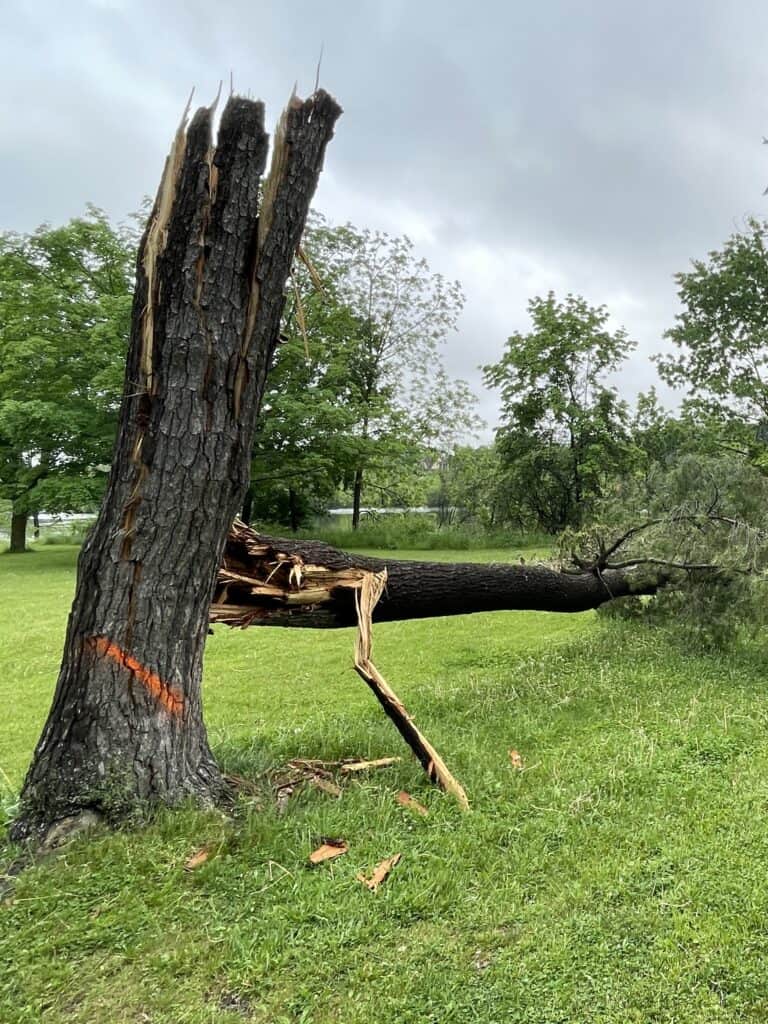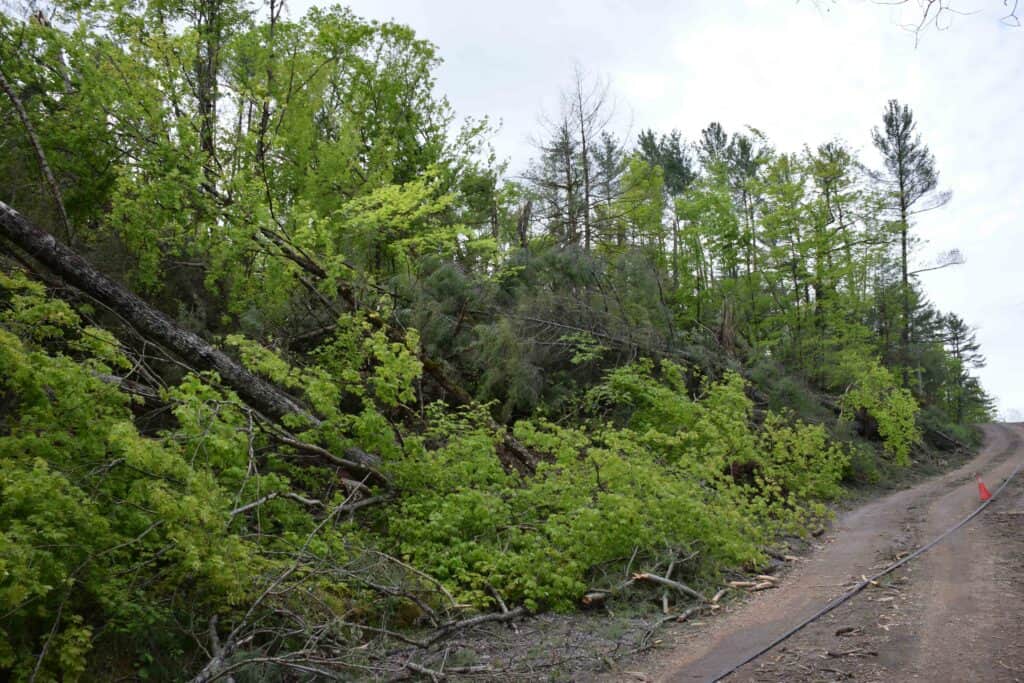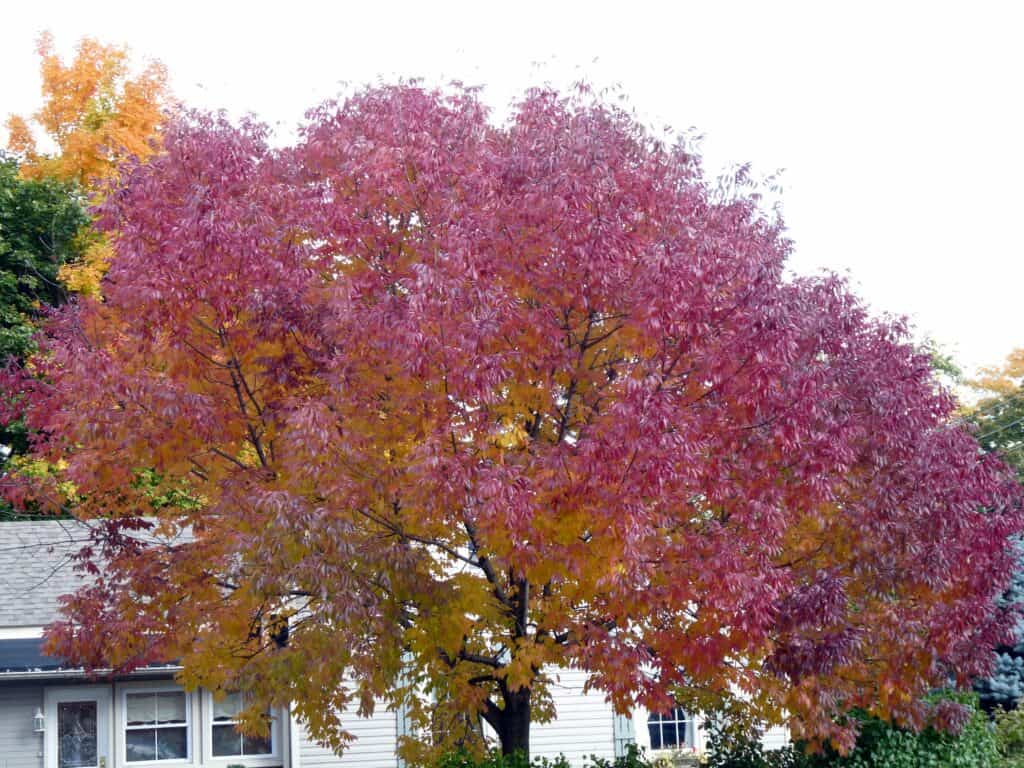Personal testimonies of the emotional impact of May’s derecho windstorm
Peterborough Examiner – September 16, 2022 – by Drew Monkman
We rarely hear about the ecological grief (sometimes called “solastalgia”) caused by the climate crisis. Many people are still reeling from the impact of May’s derecho windstorm and the loss of beautiful old trees. In many areas like Stoney Lake, the landscape has been radically changed. It’s little wonder that many of us suffer from climate-related mental health effects when these emotions are rarely discussed publicly.
On our property, a gaping hole has opened up where two beautiful native cherry trees once stood. We’d planted them almost 30 years ago and loved the spring blossoms, the shade, and the privacy they provided. They were also among the favourite trees of the many birds that visit our yard.
Many people fared far worse. Our neighbours lost four giant sugar maples, changing the character of their backyard forever. Where once there was welcome shade, there is now full sun. Mike and Sonja Barker on Algonquin Blvd mourn the loss a white pine they’d seen grow from little more than a sapling. It not only provided shade and beauty but attracted numerous birds.
In an effort to destigmatize ecological grief and make it something we can feel comfortable talking about, I invited some people to reflect on the emotional impact of the derecho. This special kind of grief is just one way climate change is increasingly impacting our well-being.
Personal testimonies
“It was only a few days after the storm that I witnessed all the destruction. Walking through Inverlea Park felt like walking through a cemetery except the deceased hadn’t been buried. Massive trees at least three times my age had toppled over. How?! I still have a sinking feeling in my stomach thinking about it now. I grieve the loss of all those trees. Especially the old ones, the native ones, the ones sheltering bird nests and helpful bugs, and the ones holding strong on the bank of the Otonabee. Both of the white pine trees I used to hang my hammock between were among the fallen.” Maya, Peterborough

“When I saw the devastation here at Camp Kawartha on Clear Lake, it was as if someone had squeezed my heart. Over 600 trees down – sugar maples, red oaks, ironwoods, basswoods, and more. For over 25 years I’ve walked among them, listening to the calming rustle of their leaves, savouring their shade on hot summer’s days, and tasting the sugary goodness of maple syrup that we make every spring. These trees aren’t just objects – they are living beings that are not only beautiful, but they engage in beautiful acts such as absorbing carbon, filtering water, moistening the air, providing food to other living things and even talking to one another by sending chemical signals through their interconnected root systems. I miss them and I grieve for them as does my staff. And while we can plant more trees, our “neighbourwood” just isn’t the same. It will take many years before we have the same kind of rich and vibrant forest we once had. Let’s take care of our trees and the forests wherein they dwell – the Earth needs more trees and so do we.” Jacob Rodenburg, Camp Kawartha, Clear Lake

“Here at Stoney Lake, the derecho caused enormous damage and a sudden and massive reconfiguration of the landscape. The loss of trees will never be replenished in my lifetime. Cottages and homes that were nicely concealed from view suddenly became completely visible.
“In my 59 years living on the lake, I have witnessed the loss of numerous trees: the disappearance of elms from Dutch elm disease; dead or disfigured sugar maples from acid rain; the loss of beech from beech bark disease; ash trees succumbing to the emerald ash borer; numerous trees perishing from the recent gypsy moth infestations; and now hemlocks threatened by the woolly adelgid. But nothing in my lifetime has ever so suddenly and so extensively destroyed so much and changed the landscape as drastically as the May 2022 derecho. Yes, the beautiful granite shoreline and the sparkle of the lake is a constant, but so much of what once was is now only a memory or photograph.” Dennis Johnson, Bayview Marina, Stoney Lake
“At our family’s three cottages on Northey’s Bay, we lost close to 100 trees. This includes one of the oldest trees on Stoney Lake. It grew in a small, wooded swamp beside the cottage that we were very fond of. Driving in, the cottage road has become almost unrecognizable. Even now, when we walk along the road, it’s terribly discouraging to see the damage. It all makes us feel sad.” Ian and Anke Blaiklock, Stoney Lake
“Our cottage property was hit very badly. The damage was devastating. Our century-old pines were either uprooted or had half their tops missing. Many lay along our eastern shore in the water. Our old red cedars suffered badly, too, and many were toppled. The storm has completely changed the look and feel of our old place. Both of us have suffered mentally. We love our old trees and the land and knowing that big adjustments have to be made deeply saddens us.
We are going to do some tree planting along the shore that is now torn up. Trees will heal it, we know. We will likely leave some trees in the water. A beaver is cutting off limbs now and the remains of trees make good wildlife habitat.
My son says “Dad, most people will like the long view and you’ll have a lot more sun.” We are shade people but we can adjust.”Ralph and Carol Ingleton, Stoney Lake.

“All I could think of while we huddled beneath the basement stairs was the welfare of the hawks, owls, and ravens whose nests I’d been keeping notes on throughout the spring. Over the weeks that followed, I managed to check on many of these. There were losses but most survived.
However, seeing the destruction of trees and even sections of forest that I knew so well has been tough to deal with. But, I found it best not to dwell on this if healing was not to be delayed. Now, I see renewal everywhere I look. All around fallen, century-old pines and oaks, I’m seeing young trees which had struggled to grow in the shadows of their ancestors that now, in just one summer, are shooting up ten times faster than before. For me it has been a lesson in letting go of what I was used to and finding comfort in the beauty and perfection of change. It’s a reminder that change is the only thing we can truly count on. Why fear or hide from it when it shows up? Grieving is important but healing from it is, too.”Tim Dyson, Douro-Dummer
And it’s not just destruction from the storm. As Dennis Johnson wrote, trees are dying from multiple causes. It is especially painful to see the countless dead ash trees everywhere. I feel their demise acutely right now as they would have been providing so much of the fall colour. Glowing in deep purple and maroon, their exquisite autumn foliage was once a key part of the fall colour parade. We are all the poorer for their passing.

You’ll soon be able to read more personal tree testimonies by visiting the Kawartha World Issues Centre’s “Stump Stories” series. Go to https://kwic.info/stump-stories. You can also submit your own stories.
CLIMATE CHAOS UPDATE
Upcoming events: On September 26, from 4 to 7:30pm, For Our Grandchildren is holding a “Protect the Planet” event to mark the third anniversary of the Peterborough Declaration of the Climate Emergency. Gather at Millennium Park for a dance featuring the Weber Brothers and Irish Millie. At 6:30, participants will walk up George St. to Confederation Park to listen to speakers and hold space around City Hall.
Carbon dioxide: The atmospheric CO2 reading for the week ending September 10 was 416.33 parts per million (ppm), compared to 413.41r ppm a year ago. Rising CO2 means more climate catastrophes ahead.